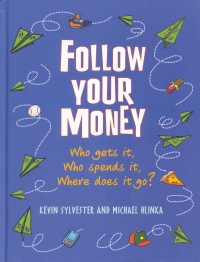| ________________
CM . . .
. Volume XX Number 2. . . .September 13, 2013
excerpt:
Follow Your Money: Who Gets It, Who Spends It, Where Does It Go? is a well-named book. It takes a look at monetary transactions and what really is included in the price of a good or service.
The equations that break down each monetary transaction provide a good amount of detail without being overwhelming to readers. The number of items listed in each equation has been limited, with extra relevant information nearby. For example, in the equations for eggs and bacon, one item is listed as “farmer’s profit”, but in a paragraph lower on the page, the authors explain how that number is not pure profit, but must cover all the farmer’s costs. There are a number of interesting equations and comparisons in Follow Your Money that will make readers of any age think carefully. The information presented not only shows why designer jeans cost more, but also why digital CDs cost almost as much to produce as physical CDs. The cost of printer ink is another eye-opener and fascinating to read about. In addition to the different types of monetary transactions, Follow Your Money briefly covers related topics, such as store sales, banking and credit cards. All the chapters contain information beyond the equations, information which supports and explains the numbers given in the equations. While all the equations provide good information, they can become rather repetitious. This is not a major issue as Follow Your Money does not have to be read in order from cover to cover. Specific information is easy to find with the help of the excellent index. Some more entries in the “Media Resources” under “Keep Reading” would be nice, especially more basic resources on the economy and monetary transactions. However, the resources listed are good, and there is also a section for “Sources”. All the sources are websites, but that is understandable in light of the material being presented, especially the specific numbers for the equations. Presented in an easy to follow format, Follow Your Money is an informative overview of where your money goes. Highly Recommended. Daphne Hamilton-Nagorsen is a graduate of the School of Library, Archival and Information Studies at the University of British Columbia, Vancouver, BC.
To comment
on this title or this review, send mail to cm@umanitoba.ca.
Copyright © the Manitoba Library Association. Reproduction for personal
use is permitted only if this copyright notice is maintained. Any
other reproduction is prohibited without permission.
NEXT REVIEW |
TABLE OF CONTENTS FOR THIS ISSUE
- September 13, 2013.
AUTHORS |
TITLES |
MEDIA REVIEWS |
PROFILES |
BACK ISSUES |
SEARCH |
CMARCHIVE |
HOME |

 Follow Your Money contains a lot of good information about monetary transactions. The book starts with a short summary of the history of money that is followed by a brief discussion of profit. From there, Follow Your Money moves on to a look at different goods and services. Each chapter has a different theme (pierced purchases, shoes, pizza, etc.) which keeps similar goods and services together and makes it easier to find out about specific goods and services.
Follow Your Money contains a lot of good information about monetary transactions. The book starts with a short summary of the history of money that is followed by a brief discussion of profit. From there, Follow Your Money moves on to a look at different goods and services. Each chapter has a different theme (pierced purchases, shoes, pizza, etc.) which keeps similar goods and services together and makes it easier to find out about specific goods and services.